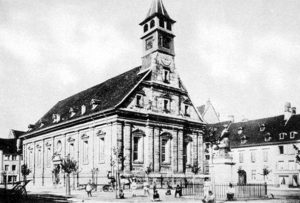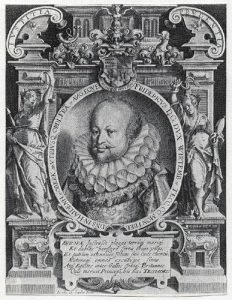Louis XV promises to tolerate Lutheranism
During the rule of Count Leopold Eberhard (1699-1723), Anabaptists evicted from the Canton de Berne were well received in the Monbéliard region. They were outstanding farmers who brought with them the best of farming methods.
During the rule of Count Karl Alexander (1733-1737) and that of his brother Karl Eugen (1736-1768), the policy imposed by King Louis XV in favour of Roman Catholicism led to constant harassment. New usurpations occurred every month. One after the other of the Protestant churches were denied to their congregations whose complaints never received any attention. This happened in Vaujeaucourt, Héricourt, Montécheroux, Langres, Chagey, Seloncourt, Boudeval. Longevelle.
On the 10th of May 1748, at Versailles, a convention putting an end to these exactions was finally signed by Count Karl Eugen and Louis XV who promised to allow Lutheran services of worship to be practised freely in the seigniorial lands. The Count, while recognizing the sovereignty of France, retained his ruling authority over them,
During the 18th century, fifteen Protestant churches were built in the villages of the Pays de Montbéliard: Sainte-Suzanne, Bethoncourt, Brevilliers, Saint-Julien, Aibre, Valentigney (demolished and replaced in 1832), Mandeure (demolished, and rebuilt in 1860), Vandoncourt, Deslé (demolished and replaced in 1872), Dampierre-les-Bois, Attenjoie, Dambenois, Étupes, Exincourt (demolished and replaced in 1845), Pierrefontaine lès Blamont.
Montbéliard in its heyday
The last Count of Montbéliard, Friedrich Eugen ruled from 1768 to 1793, and gave the Principality a somewhat prestigious image. In 1770 he had a summer residence built in Étupes. He married a niece of Frederick II, King of Prussia and two of their daughters became Empresses : Sophia Dorothea married the Grand Duke Paul of Russia, the future Czar Paul I, and her sister Elisabeth married the Archduke Francis of Austria, later to become Emperor of Austria. These unions justified the frequent visits to the Pays de Montbéliard and Étupes of Emperor Joseph II, Prince Heinrich of Prussia and the Baroness d’ Oberkirch, a loyal supporter of the court of France.
Annexation of Alsace to France
In 1790, the “seigneuries” actually became French. In fact, the inhabitants of Montbéliard had always spoken French, and their specific characteristics had prevented a real fusion with Württemberg. The “seigneuries” were annexed peacefully. Pretending that Count Friedrich Eugen had allied himself with the enemies of France, Bernard de Saintes, a member of the Convention, took possession of Montbéliard on the 10th of October, 1793.
Roman Catholicism had been forbidden church worship on French territory, and the same applied to the Lutherans. All Protestant churches were used for worship of the Supreme Being. The pastors, however, were allowed to stay in their parsonages ; meetings were held in private homes, in barns, or in school classrooms. At the end of 1795, the National Convention proclaimed the freedom of worship and the churches were returned to the congregations.
The French Revolution did not cause any bloodshed in the Pays de Montbéliard which was finally united to France in 1796 at the Paris convention by which Friedrich Eugen relinquished all his rights to France. The county was successively linked to the départements of Haute Saône, Mont -Terrible, and Haut-Rhin.It was only in 1816 that he administrative decisions to share the county between the present départements of Doubs, Haute-Saône and Haut-Rhin were taken.



